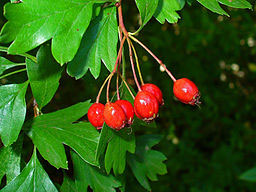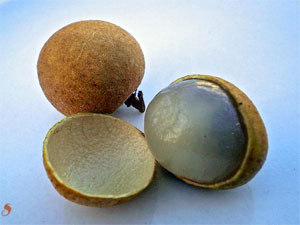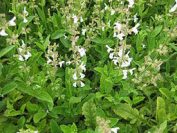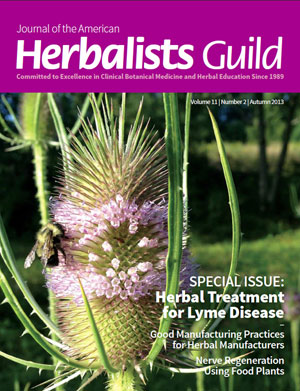HERBS – FOUR FAVORITES!
While I’ve had many favorite herbs over the years with which I’ve experienced many wonderful healings, these four are my current favorites.
Teasel (Dipsacus)
I’ve long used the Japanese variety of teasel (Dipsacus asperoides; xu duan), however one of my new favorite herbs is the Western variety (Dipsacus fullonum). Even the latest AHG Journal highlighted this herb on its cover! I first learned of western Dipsacus in the early ’90s while traveling through Scotland. There I witnessed huge machines combing wool that were comprised of hundreds of dried teasel heads on a giant spinning drum. (Dried teasel flowerheads are very hard and bristly.) Although this herb originated in Europe, this invasive weed now grows in many places. Today, teasel has made a wildly popular resurgence as an herb to treat joint, muscle and bone injuries and pain, symptoms associated with Lyme disease, and (from what I hear because I don’t have experience with this) chronic fatigue as well. However, I’ve seen it work for other conditions and I believe its application could spread even more. I recently experienced my own miraculous healing with this herb. After a skiing accident decades ago, one of my hips can go out of alignment. This just happened occurred again. Several chiropractic adjustments worked but didn’t hold. One dose of teasel not only put my bones back into alignment but also kept me there! Nothing else I’ve seen has worked this well. I also used it with my elderly bedridden mother for back/coccyx pain. One dose of three drops and she was pain-free. Another woman I gave it to had such terrible back and hip pain that she cried every morning when she had to get out of bed. One dose of Dipsacus and she immediately felt better. Several doses later, not only was her back pain minimal but also her swollen ankles were normalized so she could eliminate her medication for this. I wasn’t surprised at this response as the Chinese variety of Dipsacus is a Kidney Yang tonic, treating such conditions as the back pain and swollen ankles mentioned above. An interesting part of using western teasel is that only a few drops of the tincture are needed – typically 3-5 drops, one to three times per day are sufficient. However NOTE: This tincture is best taken on a full stomach. I’ve seen several people get stomach upset or nausea when they’ve taken Dipsacus on an empty stomach.

We’ve all known and loved hawthorn for years but now there are some new fun ways to take it that are also quite effective. Hawthorn paste Hawthorn berries may be made into a thick paste with honey. This electuary is quickly assimilated and quite tasty. As such, I’ve seen as small as ¼ teaspoon quickly regulate the heart rhythm and strengthen its function. Hawthorn wine I’ve been one of the wine tasters here for Michael’s latest brew of hawthorn wine. It’s such a delicious – and sweet – wine that not much is needed (at least for me!) and it has a beautiful dark rosy color. Get all the benefits of hawthorn (heart tonic, blood pressure, circulation, and digestive support) while enjoying it at a dinner party or as an after dinner treat! You can make the wine at home by mashing the berries, mixing with sugar and letting them ferment. When done, strain, bottle and “cap” with balloons to allow for further fermentation. When the balloons are flat, you can cork normally.
 “Dragon Eyes” – Longan Berries (Euphoria longan; long yan rou)
“Dragon Eyes” – Longan Berries (Euphoria longan; long yan rou)
When I first learned about longan berries in the early ’80s, they were called by their ancient name, “dragon eyes” (long mu) When I recently found this herb in Hawaiian markets, I learned why. Raw, these delicious fruits look like whole eyes with small black pupils! They are easy to peel, and slimy and sweet to taste, making them a perfect yin tonic for the Heart and Mind. Longan berries nourish Blood, tonify Qi and calm the Spirit. As such, they are used for palpitations, forgetfulness, dizziness, insomnia and overwork, all due to Heart and Spleen deficiency. I know one acupuncturist/herbalist who would always eat a handful of longan berries after her clinic to replenish her Heart Blood and Spleen Qi. This method is also specific for students after long hours of reading or studying!

Salvia miltiorrhiza by Raffi Kojian
There are hundreds of varieties of sage. Red sage root is one the Chinese have long used to regulate the blood. It is such a valuable herb for this that it “should” be taken by all “older” people to ensure a healthy heart and circulation and prevent heart conditions, treating blood clots, angina pectoris, coronary heart disease, and palpitations. Red sage root is also fantastic for pain due to Blood Stasis treating such conditions as chest or epigastric pain, painful menstruation, amenorrhea, and endometriosis. It also breaks up Blood Stasis, making it useful for abdominal masses, fibroids and cysts. As well, it calms the Spirit, treating irritability and helping sleep! This is truly a medicine kit in a bottle! The tincture is especially effective for pain as it quickly enters the bloodstream. It works best to take one tablespoon of the tincture every 15 minutes and reduce as pain subsides.


Hi Lesley,
What are your thoughts on hawthorn berry and the studies that show it is contradicted in people with heart palpitations in the Western Medicine?